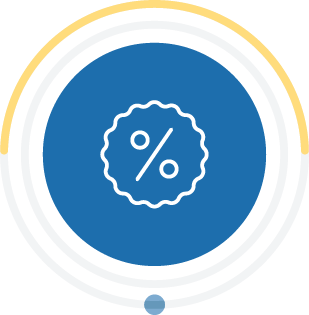







Each customer is taken care of by a dedicated sales specialist. With them you will discuss the terms of cooperation and choose the right IT service.
We verify both soft and technical skills. This is taken care of by a 10-person Talent Acquisition department along with technical recruiters.
We take care of the quality of our services by periodically collecting feedback from customers. We also study the motivation of our experts.
You gain a wide range of IT services: integrations, system and application monitoring, licenses and software, and much more....
Our leading
technologies

The world's largest provider of airline reservation distribution systems.

A global technology market leader that creates green energy networks.

One of the largest e-commerce companies in Poland and Europe.

A European leader in the e-commerce industry, operating two multi-brand platforms.

Aplikacja umożliwiająca umawianie wizyt z zakresu usług beauty.

Platforma internetowa do zarządzania zgłoszeniami klienckimi (customer service).

A company that creates innovative solutions in the banking industry.

One of Poland's largest leasing companies.

The longest-operating mortgage bank in Poland focused on mortgages.

One of the largest financial institutions.

A leader in offering modern logistics services in Poland.

Firma oferująca usługę przechowywania danych w chmurze.

Oprogramowanie księgowe głównie dla małych i średnich firm.

Leading technology provider for the financial services industry.

A platform that has an OC and AC calculator.

A gaming company with an innovative approach and passion for the world of gaming.

The world's leading hearing protection group.

A leader in the educational solutions market.

One of the world's leading telecom operators.

One of the world's largest retail companies.

A company that creates innovative smartphones and accessories.

The world's largest provider of airline reservation distribution systems.

A global technology market leader that creates green energy networks.

One of the largest e-commerce companies in Poland and Europe.

A European leader in the e-commerce industry, operating two multi-brand platforms.

Aplikacja umożliwiająca umawianie wizyt z zakresu usług beauty.

Platforma internetowa do zarządzania zgłoszeniami klienckimi (customer service).

A company that creates innovative solutions in the banking industry.

One of Poland's largest leasing companies.

The longest-operating mortgage bank in Poland focused on mortgages.

One of the largest financial institutions.

A leader in offering modern logistics services in Poland.

Firma oferująca usługę przechowywania danych w chmurze.

Oprogramowanie księgowe głównie dla małych i średnich firm.

Leading technology provider for the financial services industry.

A platform that has an OC and AC calculator.

A gaming company with an innovative approach and passion for the world of gaming.

The world's leading hearing protection group.

A leader in the educational solutions market.

One of the world's leading telecom operators.

One of the world's largest retail companies.

A company that creates innovative smartphones and accessories.
About Client
As a leading e-commerce platform in the fashion industry, Modivo has experienced rapid growth, bringing significant challenges in terms of scalability, system performance, and the speed at which new features could be delivered to the market. The existing monolithic architecture, which had initially supported the platform well, began to show its limitations as the user base expanded and the complexity of operations increased.
About the project
The primary goal of this project was to overhaul the existing architecture, focusing initially on the shopping cart module—an essential component of the Modivo platform that directly impacts customer experience and revenue generation. The objective was to transition this critical part of the system to a distributed architecture, allowing for better scalability, improved performance, and more agile development processes.
Technologies
Java / Kotlin
Spring Boot
Spring Cloud
Docker
Node.js:
Challenges
The architectural transformation posed several significant challenges:
Solution and Implementation
The transformation was carried out in several phases, with an experienced IT team taking the lead on the shopping cart module:
Competence
Web&Mobile
Industry
E-commerce
Technologies
Android
iOS
Kotlin
MangoDB
Challenges
A need has emerged to handle more orders at drop-off points, through the growing popularity of pick-up points.
Solutions
Providing functionalities ensuring that the customer can quickly and easily pick up the parcel from the parcel machine.
Competence
Web&Mobile
Industry
E-commerce
Technologies
Kotlin
Microservices
React
Challenges
Adaptation and expansion of the e-commerce platform to enable the use of a catalog of offers and the completion of demands.
Solutions
The introduction of the solution into the new market has enabled investment funds to use systems for customer acquisition, customer transaction management and reporting.
Competence
Web&Mobile
Industry
E-commerce
Technologies
Kotlin
Microservices
React
Challenges
Integration with an external partner for the purpose of settling affiliate transactions. Due to the long time needed to implement our own solution, a decision was made to use a product from an external company.
The product license assumed settlement based on the actual generated turnover, so it was necessary to generate and send lists of sold offers using an external company’s product.
Soltions
The team delivered a solution that periodically sent reports based on transaction events to an external partner.
The solution was independent, consistent with the accepted practices and technologies used in Allegro and did not involve other Allegro teams.
As a result, the team quickly produced and took over maintenance of an automatic solution that replaced the manual work of accounting departments.
Competence
Web&Mobile
Industry
E-commerce
Challenges
The project required adaptation in many business and technical areas, as well as a great deal of technical expertise to optimize the architecture and coordinate legacy services and the dependencies between them, which is a major challenge with such a distributed system.
Solutions
The implementation of Allegro Czechy was a multi-team effort.
The internationalization project required changes to existing mechanisms ranging from logistics to payments. Each area had to additionally take into account the sales in the target country.
Competence
Web&Mobile
Industry
E-commerce
Challenges
The main challenge was to enable Allegro’s expansion into the Czech market through integration with foreign shippers and an intermediary.
This integration intended to allow international returns between Poland and the Czech Republic. In addition, the project included the development of add-on services that allowed customers to choose additional options during order processing.
Solutions
The team delivered a comprehensive solution that included full integration with an intermediary and an international returns functionality. The long-term outcome of this project was Allegro’s expansion into the Czech market, which unlocked new opportunities for the company.
Competence
Mobile
Industry
E-Commerce
Technologies
Android
Kotlin
Compose
Coroutines
RxJava2
MVVM
Gradle
OpenAPI 3.x
Firebase
Sentry
Synerise
Appsflyer
Challenges
Long-term increase in the share of product revenue through the mobile app up to 50% of the company’s overall revenue.
Solutions
Modivo app (Google Play)
We are constantly increasing the revenue from the mobile app, we are aiming for a long-term goal. We have also launched an initiative to write a new version of the app ready to meet all future goals of the company, technically and business-wise.
Technologies
GCP
React
GKE
Microservices
Challenges
The challenge was to develop a solution that would allow new functionality to be rapidly deployed into the production environment. This required the creation of robust environments and seamless integration of new functionality.
Solutions
Competence
WEB
Industry
Retail
Technologies
Angular
Java
Mongo DB
Dynamo DB
AWS
Challenges
Building a common, reliable and scalable service that would be responsible for receiving event streams from various sources and, based on these events, sending notifications to specific recipients via communication channels.
Solutions
A notification service that integrates with both customer systems (providing information about subscribers and notification recipients) and notification providers (responsible for detecting events, about someone who wants to be notified).
Competence
Web&Mobile
About the client
Technologies
Java 11
Spring Boot
Rest Api
Kubernetes
Challenges
Solutions
Edge One Team successfully developed and integrated the JackDrop feature. They followed an agile approach, allowing them to iteratively test and refine the feature throughout its development cycle. The use of modern technologies such as React for the frontend and Spring Boot for the backend enabled the team to deliver a robust and scalable solution.
The reintegration process involved:
About the Client
One of the largest banks in Poland, embarked on an innovative project aimed at enabling business clients to apply for loans entirely online, without the need to visit a bank branch. The project aimed to streamline the credit process and increase the accessibility of financial services, offering clients greater convenience and time savings.
About the project
The main objective of the project was to create a fully automated credit process for business clients, covering all stages—from financing simulation, through verification, to signing the contract. This allowed the credit process to be conducted remotely through the Pekao24 electronic banking platform.
Technologies
Java,
Kafka
Swagger
OpenAPI
Angular
IBM BPM
Challenges
Implementing such a system presented several key challenges:
Solution
The project was realized using modern technologies and proven methodologies:
The implementation of the new online credit process brought several benefits to Bank Pekao:
Competence
Web&Mobile
Industry
Banking
Technologies
Java 11
Spring Boot
Spring Integration
Spock
Microservices
Challenges
The lack of a suitable solution creates excessive costs and risks for the client. A business need has emerged for a system that will help gain control over aspects of transactional tax settlement.
Solution
An IT platform that allows communication between the accounting office, the entrepreneur and the bank.
Competence
Web
Industry
Electronical&Electronical Manufactoring
Technologies
.Net
C#
WPF
WCF
DirectX
Challenges
The work is based on an analysis of the functionality of previous versions of the application, a feasibility study of a particular import in the new version, and then the implementation of the import in the new system.
Solution
The module ensures data consistency when migrating power grid projects to a new version of the system.
Competence
WEB
Industry
Fintech
Technologies
React
Java
Spring
PostgreSQL
Influxdb
Redis
Kotlin
Challenges
Creating a solution to simulate IPOs on the stock market.
Solution
Our specialists created a solution to the problem when submitting an IPO by creating a platform integrated with the stock market data provider allowing:
• Creating a new IPO
• IPO subscriptions
• Share trading
• Communication of issuers with investors
• Invitation of selected investors to a private IPO
Competence
WEB
Industry
Professional Services
Technologies
Java 11
Spring WebFlux
C++ (read only)
Rest Api, SOAP
GCP
Swagger
Kubernetes
Postman (Newman
Chai.js
Challenges
Migration from a legacy banking system implemented in C++ to a modern cloud solution using JAVA language. The key requirement of the new solution was to preserve the business logic used in the old system and to be able to flexibly extend it with new functionalities.
Solution
The implementation of 3 major applications responsible for integrating the client’s systems with separate financial institutions systems.
Industry
Professional Services
Technologies
Java
Spring
Wiremock
MockGrpc
Challenges
The main goal of the project is to rewrite the old server part of the application using the latest technologies and microservices.
Design and development of the module responsible for saving SSr in the system in one of the microservices and also converting the saved data to a format understood by the old system for verification and use with the old system.
Solution
Module/microservice for writing and reading data from SSr domain.
Industry
Industrial Machinery Manufacturing
Technologies
Java
K8S
Amazon Cloud
Amazon RDS
KMS
EKS
OIDC
Challenges
Our client’s contractors use a platform that consolidates applications from different vendors. Historically, there have been several access mechanisms, each mechanism providing access to only selected applications.
This complicates the addition of new applications/vendors.
In addition, some application providers use more than one of the authorization methods offered by the platform, which generates redundant work for system integration and increases the usage of server resources.
The consolidation was necessary, resulting in savings in platform maintenance costs.
Solution
API standardization was performed using the latest standards (e.g. OIDC), then a target cloud solution and an on-premise version compatible with the demanding Asian markets were prepared.
Selected applications were then integrated into the target solution,
and normalization and data migration between solutions was also performed.
About the client
European Government Agency
Technologies
ESRI ArcGIS
Python
MS SQL Server
Challenges
The spatial (geospatial) analysis team plays a key role in processing and analysing spatial data using ESRI ArcGIS software. As part of their duties, the team is responsible for creating cartographic products for regular reports, as well as acquiring and integrating data from external systems into the GIS environment. Performing these tasks manually was time-consuming and strained the team’s resources, creating a need to optimise and automate processes.
Solutions
In response to these challenges, a set of dedicated map project templates and scripts were developed to automate the cartographic production process. The Python API for ArcGIS was used to do this, which allowed repetitive tasks to be automated, easing the burden on the GIS team. In addition, ETL (Extract, Transform, Load) scripts were created, which enabled efficient extraction, transformation and loading of data from external systems into the GIS.
The integration of geoprocessing scripts with the web interface allowed for the creation of self-service tools that enabled end users to perform basic cartographic and analytical operations without direct support from the GIS team. With this solution, processes that previously required significant team involvement were automated, increasing efficiency and allowing the team to focus on more complex analyses and projects.





